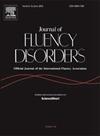Sleep parameters in children who stutter: A comparison with children who do not stutter using actigraphy
IF 2.1
3区 医学
Q1 AUDIOLOGY & SPEECH-LANGUAGE PATHOLOGY
引用次数: 0
Abstract
Purpose
This study aimed to compare objective sleep parameters in children who stutter (CWS) with those in children who do not stutter (CWNS) using actigraphy. Previous research, mainly relying on subjective methods such as questionnaires and sleep diaries, has highlighted the high prevalence of sleep disorders in individuals who stutter.
Methods
Sleep parameters, including sleep onset latency, sleep efficiency, sleep duration, and total sleep time, were objectively measured using actigraphy over 14 consecutive days. The study included 30 CWS (aged 4–12 years) and 21 CWNS (also aged 4–12 years). Data were analyzed with SPSS Statistics 28.0 software, expressed as medians with interquartile ranges (25–75 %). Group comparisons were conducted using the Mann-Whitney test. The significance level for all statistical tests was set at p < 0.05.
Results
CWS exhibited significantly longer sleep onset latency (p < 0.001) and lower sleep efficiency (p = 0.01) compared to CWNS. No significant differences were observed in total sleep time or sleep duration between the groups.
Discussion
This study provides objective evidence that CWS experience specific alterations in sleep parameters, particularly in sleep onset latency and sleep efficiency. This suggests a higher prevalence of sleep disturbances within this population. These findings highlight the importance of integrating sleep assessments into the clinical management of stuttering to improve therapeutic outcomes.
口吃儿童的睡眠参数:用活动描记法与非口吃儿童的比较
目的应用活动描记法比较口吃儿童与非口吃儿童的客观睡眠参数。先前的研究主要依靠主观方法,如问卷调查和睡眠日记,强调了口吃者睡眠障碍的高发性。方法连续14天,采用活动描记仪客观测量睡眠参数,包括睡眠发作潜伏期、睡眠效率、睡眠持续时间和总睡眠时间。该研究包括30名CWS(4-12岁)和21名CWNS(4-12岁)。数据采用SPSS统计软件28.0进行分析,以四分位数间的中位数表示(25-75 %)。采用Mann-Whitney检验进行组间比较。所有统计检验的显著性水平设为p <; 0.05。结果与CWNS相比,scws患者睡眠潜伏期明显延长(p <; 0.001),睡眠效率显著降低(p = 0.01)。两组之间的总睡眠时间和睡眠持续时间没有显著差异。本研究提供了客观证据,证明CWS在睡眠参数方面有特定的改变,特别是在睡眠开始潜伏期和睡眠效率方面。这表明这一人群中睡眠障碍的患病率更高。这些发现强调了将睡眠评估纳入口吃临床管理以提高治疗效果的重要性。
本文章由计算机程序翻译,如有差异,请以英文原文为准。
求助全文
约1分钟内获得全文
求助全文
来源期刊

Journal of Fluency Disorders
AUDIOLOGY & SPEECH-LANGUAGE PATHOLOGY-REHABILITATION
CiteScore
3.70
自引率
14.30%
发文量
23
审稿时长
>12 weeks
期刊介绍:
Journal of Fluency Disorders provides comprehensive coverage of clinical, experimental, and theoretical aspects of stuttering, including the latest remediation techniques. As the official journal of the International Fluency Association, the journal features full-length research and clinical reports; methodological, theoretical and philosophical articles; reviews; short communications and much more – all readily accessible and tailored to the needs of the professional.
 求助内容:
求助内容: 应助结果提醒方式:
应助结果提醒方式:


